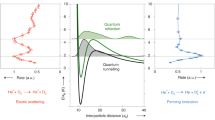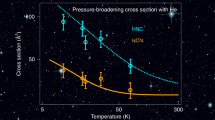Abstract
Inelastic collisions that occur between open-shell atoms and other atoms or molecules, and that promote a spin–orbit transition, involve multiple interaction potentials. They are non-adiabatic by nature and cannot be described within the Born–Oppenheimer approximation; in particular, their theoretical modelling becomes very challenging when the collision energies have values comparable to the spin–orbit splitting. Here we study inelastic collisions between carbon in its ground state C(3Pj=0) and helium atoms—at collision energies in the vicinity of spin–orbit excitation thresholds (~0.2 and 0.5 kJ mol−1)—that result in spin–orbit excitation to C(3Pj=1) and C(3Pj=2). State-to-state integral cross-sections are obtained from crossed-beam experiments with a beam source that provides an almost pure beam of C(3Pj=0) . We observe very good agreement between experimental and theoretical results (acquired using newly calculated potential energy curves), which validates our characterization of the quantum dynamical resonances that are observed. Rate coefficients at very low temperatures suitable for chemical modelling of the interstellar medium are also calculated.
This is a preview of subscription content, access via your institution
Access options
Access Nature and 54 other Nature Portfolio journals
Get Nature+, our best-value online-access subscription
$29.99 / 30 days
cancel any time
Subscribe to this journal
Receive 12 print issues and online access
$259.00 per year
only $21.58 per issue
Buy this article
- Purchase on Springer Link
- Instant access to full article PDF
Prices may be subject to local taxes which are calculated during checkout



Similar content being viewed by others
References
Phillips, T. G. & Huggins, P. J. Abundances of atomic carbon (C I) in dense interstellar clouds. Astrophys. J. 251, 533–540 (1981).
Zmuidzinas, J., Betz, A. L., Boreiko, R. T. & Goldhaber, D. M. Neutral atomic carbon in dense molecular clouds. Astrophys. J. 335, 774–785 (1988).
Herbst, E. & Yates, J. T. Jr Introduction: Astrochemistry. Chem. Rev. 113, 8707–8709 (2013).
Tanaka, K., Oka, T., Matsumura, S., Nagai, M. & Kamagai, K. High atomic carbon abundance in molecular clouds in the galactic center region. Astrophys. J. Lett. 743, L39 (2011).
Wiese, W. L., Fuhr, J. R. & Deters, T. M. Atomic transition probabilities of carbon, nitrogen and oxygen. A critical data compilation. J. Phys. Chem. Ref. Data, Monograph 7 (1996).
Stark, A. A. et al First detection of 492 GHz [C I] emission from the large Magellanic cloud. Astrophys. J. 480, L59–L62 (1997).
Geppert, W. D. et al Combined crossed-beam studies of C(3Pj) + C2H4 → C3H3+H reaction dynamics between 0.49 and 30.8 kJ mol–1. J. Chem. Phys. 119, 10607–10617 (2003).
Kaiser, R. I., Nguyen, T. L., Mebel, A. M. & Lee, Y. T. Stripping dynamics in the reactions of electronically excited carbon atoms, C(1D), with ethylene and propylene—production of propargyl and methylpropargyl radicals. J. Chem. Phys. 116, 1318–1324 (2002).
Leonori, F. et al Unraveling the dynamics of the C(3P,1D) + C2H2 reactions by the crossed molecular beam scattering technique. J. Phys. Chem. A 112, 1363–1379 (2008).
Chin, C.-H., Chen, W.-K., Huang, W.-J., Lin, Y.-C. & Lee, S.-H. Exploring the dynamics of reaction C(3P) + C2H4 with crossed beam/photoionization experiments and quantum chemical calculations. J. Phys. Chem. A 116, 7615–7622 (2012).
Even, U. The Even–Lavie valve as a source for high intensity supersonic beam. EPJ Tech. Instrum. 2, 17 (2015).
Jankunas, J., Reisyan, K. S. & Osterwalder, A. Preparation of state purified beams of He, Ne, C, N, and O atoms. J. Chem. Phys. 142, 104311 (2015).
Le Picard, S. D. et al Experimental and theoretical study of intramultiplet transitions in collisions of C(3P) and Si(3P) with He. J. Chem. Phys. 117, 10109–10120 (2002).
Pouilly, B., Orlikowski, T. & Alexander, M. H. Fully ab initio dynamics of fine-structure-changing transitions in collisions of Mg(3s3p 3P) with He. J. Phys. B18, 1953–1967 (1985).
Alexander, M. H. et al. HIBRIDON package (College Park, MD: University of Maryland at College Park, 2011).
Gubbels, K. B. et al Resonances in rotationally inelastic scattering of OH(X2Π) with helium and neon. J. Chem. Phys. 136, 144308–144313 (2012).
Colbert, D. T. & Miller, W. H. A novel discrete variable representation for quantum mechanical reactive scattering via the S‐matrix Kohn method. J. Chem. Phys. 96, 1982–1991 (1992).
Bergeat, A., Onvlee, J., Naulin, C., van der Avoird, A. & Costes, M. Quantum dynamical resonances in low-energy CO(j=0)+He inelastic collisions. Nat. Chem. 7, 349–353 (2015).
Costes, M. & Naulin, C. Observation of quantum dynamical resonances in near cold inelastic collisions of astrophysical molecules. Chem. Sci. 7, 2462–2469 (2016).
Pentlehner, D. et al Rapidly pulsed helium droplet source. Rev. Sci. Instrum. 80, 043302 (2009).
Naulin, C. & Costes, M. Experimental search for scattering resonances in near cold molecular collisions. Int. Rev. Phys. Chem. 33, 427–446 (2014).
Knowles, P. J., Hampel, C. & Werner, H.-J. Coupled cluster theory for high spin, open shell reference wave functions. J. Chem. Phys. 99, 5219–5227 (1993); erratum: 112, 3106–3107 (2000).
Acknowledgements
A.B., M.C., F.L., S.B.M. and C.N. acknowledge financial support from the Programme National ‘Physique et Chimie du Milieu Interstellaire’ (PCMI) of CNRS/INSU with INC/INP, co-funded by CEA and CNES, and the Agence Nationale de la Recherche, contract Hydrides (ANR-12-B505-0011-02). J.K. and F.L. acknowledge financial support from the US National Science Foundation grant no. CHE-1565872. The authors thank N. Lavie for constructing the DBD pulsed valve source, and M. Alexander for support and discussions about the quantum nature of resonances.
Author information
Authors and Affiliations
Contributions
A.B., S.C., M.C., S.B.M. and C.N. carried out the experimental measurements and data analysis, with the contribution of U.E. for the development of the carbon source. J.K. and F.L. performed the theoretical calculations. All authors discussed the results and contributed to the manuscript.
Corresponding authors
Ethics declarations
Competing interests
The authors declare no competing interests.
Additional information
Publisher’s note: Springer Nature remains neutral with regard to jurisdictional claims in published maps and institutional affiliations.
Supplementary information
Supplementary Information
Supplementary Methods, Figures 1–7 and Table 1
Rights and permissions
About this article
Cite this article
Bergeat, A., Chefdeville, S., Costes, M. et al. Understanding the quantum nature of low-energy C(3Pj) + He inelastic collisions. Nature Chem 10, 519–522 (2018). https://doi.org/10.1038/s41557-018-0030-y
Received:
Accepted:
Published:
Issue Date:
DOI: https://doi.org/10.1038/s41557-018-0030-y
This article is cited by
-
Mapping partial wave dynamics in scattering resonances by rotational de-excitation collisions
Nature Chemistry (2022)
-
Determining the nature of quantum resonances by probing elastic and reactive scattering in cold collisions
Nature Chemistry (2021)
-
Two luminescent cadmium(II) coordination compounds based on tetrazole–carboxylates
Journal of the Iranian Chemical Society (2020)



